Ditapis dengan
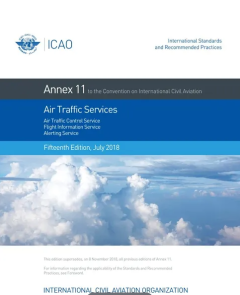
ANNEX 11 Air Traffic Services
The Standards and Recommended Practices applicable to Aeronautical Charts
- Edisi
- -
- ISBN/ISSN
- ANN-00011-015-01
- Deskripsi Fisik
- -
- Judul Seri
- -
- No. Panggil
- 629.136 6 IINT a

ANNEX 8 Airworthiness of Aircraft
Annex 8 includes broad standards which define, for application by the national airworthiness authorities, the minimum basis for the recognition by States of Certificates of Airworthiness for the purpose of flight of aircraft of other States into and over their territories, thereby achieving, among other things, protection of other aircraft, third parties and property. It is recognized that ICAO…
- Edisi
- -
- ISBN/ISSN
- ANN-00008-012-01
- Deskripsi Fisik
- -
- Judul Seri
- -
- No. Panggil
- 629.132 3 INT a
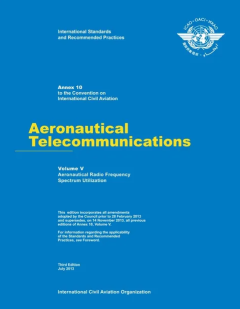
ANNEX 10 Aeronautical Telecomunication
Volume V of Annex 10 contains Standards and Recommended Practices and guidance material on the utilization of aeronautical frequencies.
- Edisi
- -
- ISBN/ISSN
- ANN-00010-003-05
- Deskripsi Fisik
- -
- Judul Seri
- -
- No. Panggil
- 629.132 51 INT a
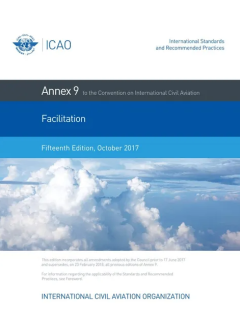
ANNEX 9 Facilitation
Annex 9 provides a frame of reference for planners and managers of international airport operations, describing maximum limits on obligations of industry and minimum facilities to be provided by governments. In addition, Annex 9 specifies methods and procedures for carrying out clearance operations in such a manner as to meet the twin objectives of effective compliance with the laws of States a…
- Edisi
- -
- ISBN/ISSN
- ANN-00009-015-01
- Deskripsi Fisik
- -
- Judul Seri
- -
- No. Panggil
- 387.736 2 INT f
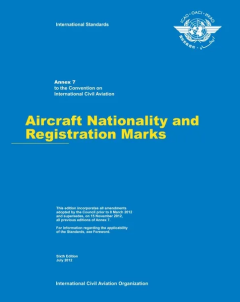
ANNEX 7 Aircraft Nationality and Registration Mark
Annex 7 contains Standards adopted by the International Civil Aviation Organization as the minimum Standards for the display of marks to indicate appropriate nationality and registration which have been determined to comply with Article 20 of the Convention. Standards for Aircraft Nationality and Registration Marks were first adopted by the Council on 8 February 1949 pursuant to the provisions …
- Edisi
- -
- ISBN/ISSN
- ANN-00007-006-01
- Deskripsi Fisik
- -
- Judul Seri
- -
- No. Panggil
- 629.130 2 INT a
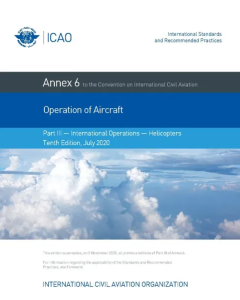
ANNEX 6 Operation of Aircraft
The Standards and Recommended Practices contained in Annex 6, Part III, shall be applicable to all helicopters engaged in international commercial air transport operations or in international general aviation operations, except that these Standards and Recommended Practices are not applicable to helicopters engaged in aerial work
- Edisi
- -
- ISBN/ISSN
- ANN-00006-010-03
- Deskripsi Fisik
- -
- Judul Seri
- -
- No. Panggil
- 629.132 52 INT o
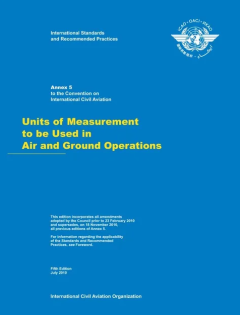
ANNEX 5 Units of measurement
This Annex comprises the Standards and Recommended Practices for dimensional units to be used in air and ground operations. The Annex deals with the standard application of units of measurement and termination of the use of non-SI units. Attachments to the Annex contain material describing the development of the International System of Units (SI) and guidance on the application of the SI, conve…
- Edisi
- -
- ISBN/ISSN
- ANN-00005-005-01
- Deskripsi Fisik
- -
- Judul Seri
- -
- No. Panggil
- 629.134 5 INT u
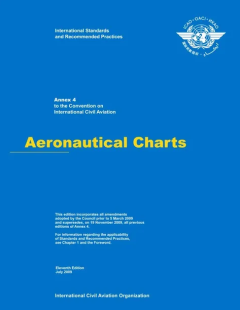
ANNEX 4 Aeronautical Chart
The Standards and Recommended Practices applicable to Aeronautical Charts
- Edisi
- -
- ISBN/ISSN
- ANN-00004-011-01
- Deskripsi Fisik
- -
- Judul Seri
- -
- No. Panggil
- 629.132 54 INT a

KP 93 Tahun 2015
- Edisi
- -
- ISBN/ISSN
- -
- Deskripsi Fisik
- -
- Judul Seri
- -
- No. Panggil
- 354.76 DIR k
- Edisi
- -
- ISBN/ISSN
- -
- Deskripsi Fisik
- -
- Judul Seri
- -
- No. Panggil
- 354.76 DIR k

Transportasi Udara 2005-2024
- Edisi
- -
- ISBN/ISSN
- -
- Deskripsi Fisik
- -
- Judul Seri
- -
- No. Panggil
- 354.76 DIR t
- Edisi
- -
- ISBN/ISSN
- -
- Deskripsi Fisik
- -
- Judul Seri
- -
- No. Panggil
- 354.76 DIR t
− ANNEX 3 Meteorology for International Air Navigation
- Edisi
- -
- ISBN/ISSN
- -
- Deskripsi Fisik
- -
- Judul Seri
- -
- No. Panggil
- 629.132 51 INTm
- Edisi
- -
- ISBN/ISSN
- -
- Deskripsi Fisik
- -
- Judul Seri
- -
- No. Panggil
- 629.132 51 INTm
Annex 2 - Rules Of The Air
The rules in Annex 2 consist of general rules, visual flight rules and instrument flight rules and apply without exception over the high seas and over national territories to the extent that they do not conflict with the rules of the State being overflown.
- Edisi
- -
- ISBN/ISSN
- ANN-00002-010-01
- Deskripsi Fisik
- -
- Judul Seri
- -
- No. Panggil
- 629.132 3 INT r
CASR Part 01 Definition & Abreviation
- Edisi
- -
- ISBN/ISSN
- -
- Deskripsi Fisik
- -
- Judul Seri
- -
- No. Panggil
- 629.130 2 INT p
- Edisi
- -
- ISBN/ISSN
- -
- Deskripsi Fisik
- -
- Judul Seri
- -
- No. Panggil
- 629.130 2 INT p
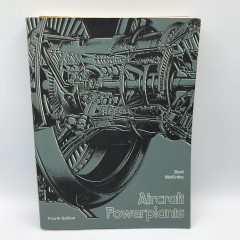
Aircraft Powerplants Fourth Edition
-
- Edisi
- 4
- ISBN/ISSN
- 9780070047921
- Deskripsi Fisik
- ill.
- Judul Seri
- -
- No. Panggil
- L-AMT-ApBM-I1-1>2
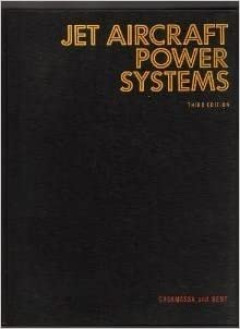
jet aircraft power systems, 3rd edition
- Edisi
- 3
- ISBN/ISSN
- -
- Deskripsi Fisik
- -
- Judul Seri
- -
- No. Panggil
- L-AMT-JtJB-I1-1>2
- Edisi
- 3
- ISBN/ISSN
- -
- Deskripsi Fisik
- -
- Judul Seri
- -
- No. Panggil
- L-AMT-JtJB-I1-1>2
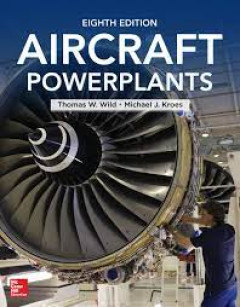
Aircraft powerplants
Aircraft Powerplants, Seventh Edition, part of the Glencoe Aviation Technology Series (formerly the Northrop Series), is the most comprehensive up-to-date powerplant book on the market today. It has been revised to reflect the latest changes in FAR Part 147 and changing industry needs. The new edition features expanded coverage of turbine engine theory and nomenclature. It also includes additi…
- Edisi
- 7
- ISBN/ISSN
- 978-0070047976
- Deskripsi Fisik
- 596 hlm
- Judul Seri
- -
- No. Panggil
- 629.13435 RAL a
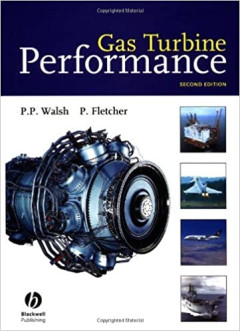
Gas Turbine Performance: 2nd edition
A significant addition to the literature on gas turbine technology, the second edition of Gas Turbine Performance is a lengthy text covering product advances and technological developments. Including extensive figures, charts, tables and formulae, this book will interest everyone concerned with gas turbine technology, whether they are designers, marketing staff or users.
- Edisi
- 2
- ISBN/ISSN
- 9781405151030
- Deskripsi Fisik
- -
- Judul Seri
- -
- No. Panggil
- 621.406 PHI g
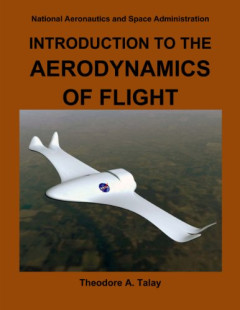
Introduction to the Aerodynamics of Flight
The science of aerodynamics can be traced back thousands of years to its beginnings but, remarkably, only one human life span has separated the first heavier-than-air powered airplane flight at Kitty Hawk from the first manned moon landing. The last few decades have witnessed phenomenal growth in the science and technology of aerodynamics and no letup is in sight. For those who possess an i…
- Edisi
- -
- ISBN/ISSN
- -
- Deskripsi Fisik
- 246 p.
- Judul Seri
- -
- No. Panggil
- 629.1323 THE i
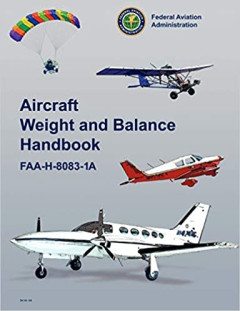
Aircraft Weight And Balance Handbook
Aircraft Weight and Balance Handbook This handbook begins with the basic principle of aircraft weight and balance control, emphasizing its importance and including examples of documentation furnished by the aircraft manufacturer and by the FAA to ensure the aircraft weight and balance records contain the proper data. Procedures for the preparation and the actual weighing of an aircraft…
- Edisi
- -
- ISBN/ISSN
- 978--1-61608-124-9
- Deskripsi Fisik
- ix 245 hal.; 28 cm
- Judul Seri
- -
- No. Panggil
- 629.134 52 FED a
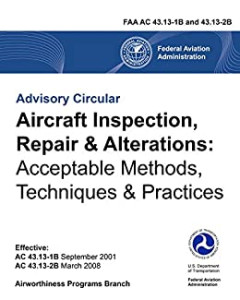
Aircraft Inspection and Repair (Acceptable Methods Techniques And Practices)
The bible for the AMTs and aircraft owners alike, this reference outlines standards for acceptable methods, techniques, and practices for the inspection, repair, and alteration of aircraft. This is Advisory Circular 43.13-1B/2A.
- Edisi
- -
- ISBN/ISSN
- 978-1560274889
- Deskripsi Fisik
- -
- Judul Seri
- -
- No. Panggil
- 629.1346 FAD a
 Karya Umum
Karya Umum  Filsafat
Filsafat  Agama
Agama  Ilmu-ilmu Sosial
Ilmu-ilmu Sosial  Bahasa
Bahasa  Ilmu-ilmu Murni
Ilmu-ilmu Murni  Ilmu-ilmu Terapan
Ilmu-ilmu Terapan  Kesenian, Hiburan, dan Olahraga
Kesenian, Hiburan, dan Olahraga  Kesusastraan
Kesusastraan  Geografi dan Sejarah
Geografi dan Sejarah